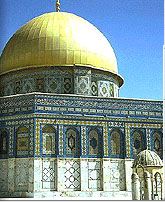|
courtesy of Yad Ben Zvi
|
|

Fortifications

courtesy of Yad Ben Zvi |
It seems that the city walls of Jerusalem had not been damaged by the Islamic conquest of the city. The Byzantine walls presumably continued in use, at least until the Fatimid period (940-1073 CE).
The Northern Wall
In the north, the Byzantine wall had clearly continued in use, as had the Damascus Gate (the Byzantine St. Stephen's Gate). Excavations carried out in the 1930s to the east of Herod's Gate indicated that parts of the northern wall underwent repairs during the Islamic period.
The Western Wall
The western line of fortifications consisted chiefly of the fortress known as 'David's Tower'. Excavations in the fortress exposed segments of a wall and a round tower, which were identified with the 'Believers' Palace' mentioned in the Aphroditoi Papyri from Egypt (701�716 CE). The function of the wall and the tower is not clear, since the First Wall of the Second Temple period continued in use through the Early Islamic period. |
The Southern (Ophel) Wall
The reconstruction of the southern wall of Jerusalem in the Early Islamic period has proved to be difficult. This wall line is commonly attributed to the Byzantine empress Eudocia (fifth century CE). It was at some points been built atop ancient walls of the First or Second Temple periods. This wall line was in use for many centuries until the Fatimid rule, when the city contracted in size. The fact that the Islamic period southern wall followed along the lines of its Byzantine forerunner is documented in a description of a pilgrim, Bernard Monachus (870 CE), locating the Churches of Mount Zion and St. Peters in the center of the city. This seems to indicate that the southern wall was to the south of its present-day position.
The southern wall was first identified by Charles Warren (1867-1870) in his excavations in the Ophel area, south of the Temple Mount
(hereinafter: the Ophel Wall). Warren was able to follow this wall along some 250 meters. This wall has towers and bosses projecting from it, but no gates were observed. Warren had uncovered the meeting point of the Ophel Wall with the southeastern corner of the Temple Mount, where he dug a deep shaft. It showed that the wall was composed of three elements: (1) A foundation constructed of roughly-hewn stones; (2) a wall, built of medium-sized ashlars, constructed in regressing rows; (3) the wall's top built of large ashlars. This was discerned only near the convergence of the wall with the corner of the Temple Mount.
Excavations in 1968-1977 revealed that at the beginning of the Islamic period the Byzantine wall was restored, and a new wall, 1.5-2.0 meters wide, was built atop it, clearly of inferior workmanship. |
|
The Eastern Wall
The line of the eastern wall of the city of the Early Islamic period seems to follow the line of the eastern wall of the Temple Mount. The Golden Gate, which is incorporated into this wall, should probably be dated to the Byzantine period, since the emperor Heraclius constructed it in 629 to celebrate of the return of the Holy Cross from its exile in Persia. It is assumed that this gate continued in use during the Early Islamic period similarly to the eastern wall of the Temple Mount.
|

|


